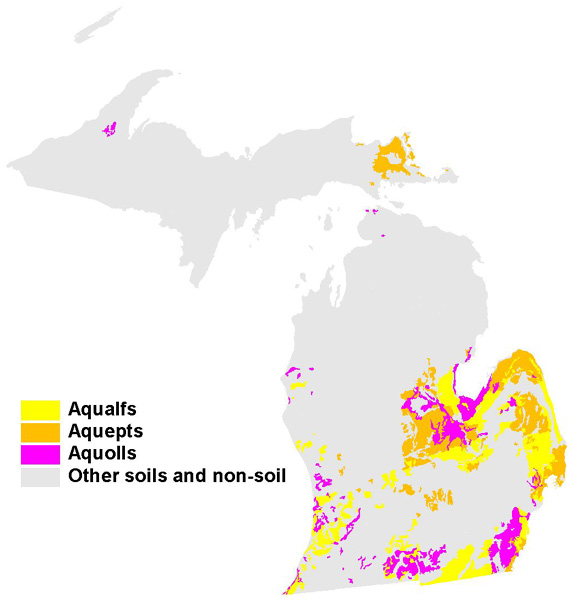In the southern part of the Lower Peninsula, the dominant soil color changes from gray to a gray-brown, because of the change in the dominant type of natural vegetation from a pine to a deciduous or broad-leaved forest---a combination of oak, beech, and hickory. This type of vegetation gives rise to more undecayed and partially decayed humus in the A horizon of the soil, and thus the change in color from gray to gray-brown. The soil is characterized by accumulations of clay in the B horizon, but the longer growing season and the deciduous vegetation results in a generally more productive soil than that in northern Michigan. Its greater fertility results from more humus, a higher mineral content, and the longer growing season, which results in a greater breakdown of the surface organic material as well as permitting a greater variety of crops.
The result is that the best general farming region of the state is in the area where the soils are classified as Alfisols. Certain crops, such as corn, can be grown for cash, partly because of the more suitable soil and partly because of the longer and warmer growing season. Dairying is also important in this part of the state, but overall, the area is characterized by mixed farming.
Alfisols are one of the eleven soil orders. Michigan has many hectares of Alfisols, such as those shown here. Alfisols are forest soils that have relatively high native fertility. These soils are well developed and contain a subsurface horizon in which clays have accumulated. Alfisols are mostly found in temperate humid and subhumid regions of the world. This, along with the native fertility, allows Alfisols to be very productive soils for agriculture and silviculture.

Click here for full size image (290 kb)
Alfisols form in loamy parent materials that
are not too sandy or too clayey. These soils formed under forest vegetation. They
are prominent across the southern lower peninsula and the western UP. Much of Michigan's
most productive ag lands are based on Alfisols.

All of the non-gray areas on the map above are dominated by wet soils, many of which
are Alfisols. The yellow areas (Aqualfs) are the wet Alfisols.
Alfisols have a thin, dark A horizon, rich in organic matter and nutrients. Below, the
light-colored E horizon represents maximal eluviation, or translocation of clay, Fe and
aluminum. The B horizon below, the zone of illuviation, accumulates clay, organic matter,
and various cations that have been translocated from horizons above. The B horizon is
better seen on the upper photo, where it shows up as a thick red horizon (layer) about a
meter below the surface.
Parts of the text on this page have been modified from L.M. Sommers' book entitled, "Michigan: A Geography".
This material has been compiled for educational use only, and may not be reproduced without permission. One copy may be printed for personal use. Please contact Randall Schaetzl (soils@msu.edu) for more information or permissions.